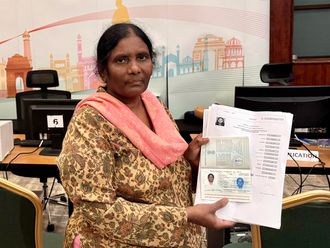How does a photographer pay a tribute to the talent and memory of a friend, also a photographer? If he is 28-year-old Binu Bhaskar, an Indian living in Australia, he walks. And takes pictures. And has a huge installation in the home town of the friend who is no more. Acquainting the town with this friend's talent and paying him the ultimate tribute.
Bhaskar's "photographic pilgrimage" spanned nearly 600 kms and four months. He set out to walk through the Gippsland district of Victoria, southern Australia, in April 2000. He crossed hills and fields and towns in the chill of winter, temperatures plunging down to 8 degrees Celsius below zero and the wind bringing in freezing rain.
He walked with his trusted Nikon, tent, and backpack crammed with clothes and films, wearing his sturdy boots and a large, warm blanket holed off at the neck to form a poncho. And he averaged 20 kms a day. "Yes, it was cold. In the first week I was just hurting all the time. But after that I got used to it. Everything seemed possible then," he remembers.
Bhaskar is now in Dubai both to promote a friend's company and to do a mural for one of the city's shopping malls. He has a post-graduate diploma in illustrative photography from the Photography Studies College South Melbourne and photography remains his main passion and vocation. That is why when fellow-photographer and friend Jason Holmes passed away, he decided to create a "pictorial obituary".
He called his obituary-pilgrimage diksa, a Sanskrit word meaning initiation. "It was meant to be both a tribute to my friend and an initiation for myself, an initiation to self-awareness in harmony with nature," he explains.
His journey began at Coal Creek Heritage Village in Korumburra. His route took him through Mardan, Mirboo North, Boolarra, Yinnar, Gunyah, the Strzelecki Forest, Foster, Port Franklin, Welshpool, Port Albert, Yanakie, Fish Creek, Meeniyan, Dumbalk and Leongatha before he reached Toora, the little country town where his friend Jason was born.
The Landscape keeps changing in Australia |
On the way Bhaskar took photographs. Stunning frames of scenery, moving portraits of smiling children and laughing old men, unusual angles of boats berthed in clusters. "The walk deeply affected the photographs I took because a photograph freezes a moment in space and time. The space was endless around me and so was time. I met no one for hours and I could see beyond horizons."
When he did meet others, in towns and farm steads, he made friends and influenced people. "I began with just a dollar in my pocket. And then support rolled in. I was interviewed and written about in the press and the people, including local governments, helped me everywhere. I did not have to spend a single night out in the cold. I was invited home and given a warm room and bed. And I mostly shared my big meal of the day (around 6.00pm) with welcoming families," he says.
"I think the people were impressed with my courage. Everyone sits by their fires in winter. No one is ready to go out in the rain and cold. And there I was, walking!"
He showed his appreciation of this generosity through work. Once he chopped a "truck load of wood for a woodcutter"; often he helped around the house and once he volunteered to go shark fishing. "This was an amazing experience. The fishing team was one crew short so I was taken in. We were on this sophisticated boat out in Bass Strait for eight days and I saw the lunar eclipse from the boat itself. I will never forget it," he stresses.
Bhaskar also succeeded in linking artistes throughout Gippsland. He contacted painters, photographers, sculptors and helped them contact each other. He spoke about photography in schools and demonstrated the fine art through slides. And finally, when he reached Toora, he erected an installation in memory of his friend and the journey.
"The whole town of around 500 people joined in and a band played music too. Jason was not very well known in his home town because most of his work was done in Melbourne. But by then everyone knew him. I installed a memory of things I saw – photographs, everyday things like bag and coat, ladders, chairs, building materials... and within this memory was the memory of Jason," he details.
Inspired by the success of his photographic pilgrimage, Bhaskar knows what he wants to do in the future. "I want to travel. To walk in different parts of the world and create more photographic memories." And he wants to produce a book of his photographs, sharing with readers his unique view of life.












